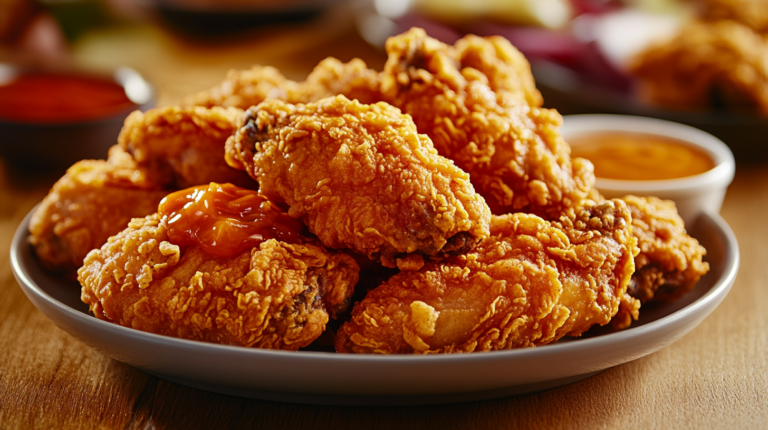Protein Powerhouse: Muscle-Building Benefits of Chicken Wings
One of the primary nutritional benefits of chicken wings is their impressive protein content. Protein is essential for muscle repair, growth, and overall body function. For every 100 grams of chicken wings, you’re getting approximately 20 grams of protein. This makes them an ideal snack for those looking to increase their protein intake in a tasty and satisfying way.
Fat Content: Healthy Fats vs. Saturated Fats in Chicken Wings
While chicken wings are protein-rich, they are also known for their fat content. This is because the wings have skin, which contains fats that add to the flavor and moisture. Approximately 15 grams of fat per 100 grams of chicken wings can be found, with a mix of saturated and unsaturated fats. Learning the difference and balancing intake can help wings remain a part of a balanced diet.
Caloric Count: Energy Levels Per Serving of Chicken Wings
A serving of chicken wings typically provides around 203 calories per 100 grams. While this may seem high, understanding portion sizes and pairing wings with nutritious sides can help keep your calorie intake balanced.
Sodium Levels: Managing Salt Intake with Chicken Wings
One area where chicken wings might not shine as brightly is their sodium content. Salt is a popular addition to wings, both in the cooking process and in sauces. A 100-gram serving of wings contains approximately 250 mg of sodium, which could contribute to high blood pressure and water retention if not balanced with a low-sodium diet.
Cholesterol and Heart Health: What to Know About Chicken Wings
For those mindful of cholesterol intake, it’s worth noting that chicken wings have about 70 mg of cholesterol per 100 grams. Consuming them occasionally can fit within heart-healthy guidelines, but portion control is key, especially if other parts of your diet are cholesterol-rich.
Carbohydrate Count: Low-Carb Appeal of Unbreaded Wings
Chicken wings are naturally low in carbohydrates, making them a great choice for low-carb diets when served without breading or sugary sauces. A plain, unbreaded wing has almost zero carbs, which is ideal for those on keto or similar diets.
Vitamins and Minerals: Nutritional Highlights Beyond Protein and Fat
Chicken wings contain beneficial vitamins and minerals, including B vitamins, which support energy levels, and minerals such as phosphorus and selenium that promote cellular health. These nutrients add to the nutritional profile of wings, giving them benefits beyond protein and fat.
Grilled vs. Fried: How Cooking Methods Affect Nutrition
The nutritional impact of chicken wings can vary greatly based on the cooking method. Fried wings generally have higher fat content, while grilled or baked wings are leaner. For those seeking a healthier option, grilling is an excellent choice, offering flavor without the added calories from frying oils.
Sauce Matters: Nutritional Impact of Popular Chicken Wing Sauces
Sauces can add flavor and calories to chicken wings. From classic buffalo to honey mustard, sauces can range from tangy and spicy to sweet. While a buffalo or hot sauce is low in calories, sweeter options like barbecue or honey garlic may contain added sugars.
Marinades and Seasonings: Enhancing Flavor Without Extra Calories
Marinades and dry rubs are excellent ways to add flavor to chicken wings without the added calories or sugars found in some sauces. Using herbs, spices, and a touch of olive oil can bring out rich flavors while keeping the nutritional impact minimal.
Portion Control: Serving Sizes and Nutritional Balance
One of the best ways to enjoy chicken wings without overdoing it is to be mindful of portion sizes. A serving of four to five wings provides a satisfying experience without overloading on calories or fats, especially when paired with veggies or a salad.
Healthier Pairings: Complementing Chicken Wings with Nutrient-Dense Sides
Pairing chicken wings with nutrient-dense sides can round out a meal and add balance. Vegetables like carrots, celery, or a leafy salad can provide fiber and vitamins that complement the protein-rich wings, helping you enjoy a more balanced meal.
Alternative Wing Options: From Cauliflower to Plant-Based Proteins
For those seeking a lower-calorie or plant-based option, alternatives like cauliflower wings or plant-based “chicken” wings offer a similar flavor profile with fewer calories and fat. These alternatives are especially popular in vegan and health-conscious communities.
Incorporating Chicken Wings into Different Diets
Chicken wings can be tailored to fit into a variety of diets, including low-carb, high-protein, and even ketogenic diets. With a few modifications to portion sizes and cooking methods, wings can be enjoyed while adhering to dietary preferences and goals.
Conclusion: Enjoying Chicken Wings as Part of a Balanced Diet
While chicken wings may not traditionally be associated with healthy eating, they can be part of a balanced diet when enjoyed in moderation and paired with nutrient-dense sides. By choosing the right cooking methods, sauces, and portion sizes, you can savor this beloved snack without compromising on nutrition. After all, food is about enjoyment as well as sustenance, and chicken wings offer a delightful balance of both.
Post Disclaimer
The information contained in this post is for general information purposes only. The information is provided by Daily recipes and while we endeavour to keep the information up to date and correct, we make no representations or warranties of any kind, express or implied, about the completeness, accuracy, reliability, suitability or availability with respect to the website or the information, products, services, or related graphics contained on the post for any purpose.

